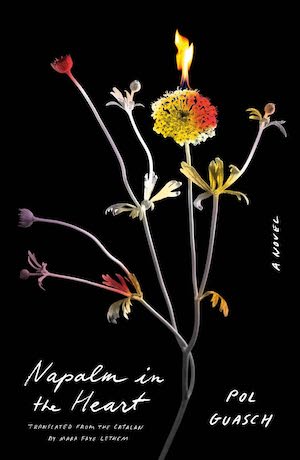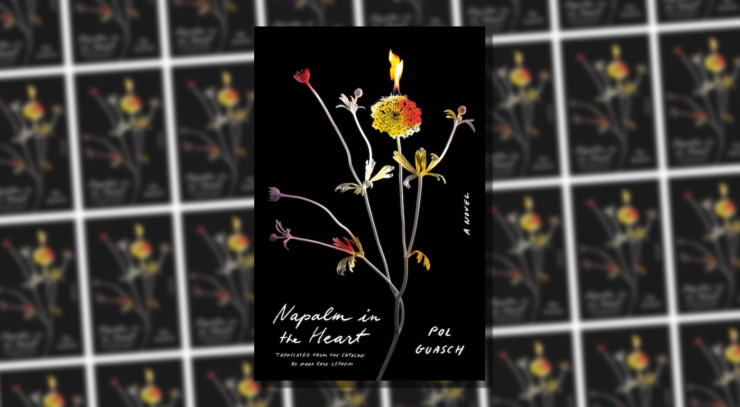Napalm in the Heart, freshly translated from the Catalan by Mara Faye Lethem, traces the invisible gulf between reality and imagination, where the latter embodies all the white lies we tell ourselves to persist in a material reality that simply doesn’t know what to do with us. Pol Guasch’s latest novel is a strange and capricious creature—a mixture of epistolary and first-person storytelling with an almost confessional quality, gathered together in short vignettes and memories, occasionally interspersed with photographs and other narrative ephemera. I just finished reading it at a curious time in my own life, about to bite the bullet on a difficult necessity, though a part of me—in small bursts of petulance that echo the book’s nameless young protagonist—simply wants to lay down like an immovable object.
Unlike this protagonist, I don’t have Guasch to propel me through the chaos and misery of a post-war pseudo-Catalonia (or at least, a vaguely analogous land robbed of its language and identity). But I do have his neighbor, Vita. Vita is old and rough and practical; she can kill a pig with a single blow and gets rowdy all night on rivers of liquor with the other old women whose husbands left or died. Vita has no bottom teeth left and waters the graves in her garden; she is the scabby old backbone left in this corner of the world, between the forest and the empty city over the hill. I think about Vita for the entire duration of the novel, even after the protagonist leaves his home far behind, and I know that she’s doing just fine. “My house is my homeland,” she prays. “And in my homeland I will never get sick.”
Guasch is vague about what has befallen these people, but he doesn’t need to spell things out to paint a familiar picture of military occupation, subjugation, and razor-wire partitions; there has been a colonization of land and language over the course of years, and these are the disparate souls who have been left behind in the wake of some kind of plague or phenomenon that required the city to be cleansed. The protagonist writes to his lover Boris, who lives in the abandoned city, and ruminates on The Factory in the forest, where many women, including his mother, used to work. He notes that its nondescript white facade bears the word PURITY, but his thoughts return time and time again to the back door, where countless people filed in and never came out. The Factory stays an enigma even as it endures as dead, ruined aberration—maybe a root cause of so many symptoms that have long outlived it.
Buy the Book


Napalm in the Heart
But The Factory, for all its mystery—its presence, even as a memory, sticks out like an otherworldly thumb amidst the protagonist’s thoughts—is not the road to a neat conclusion. It’s messy and meandering and sits in the broad no-man’s land between popular speculative fiction—the big blunt post-apocalyptic landscapes that overcrowd the genre—and the loose silhouette of magical realism in the form of the protagonist’s unforgiving, inscrutable environment. There is nothing especially clear about whether Napalm is a speculative work, but there is beauty in dwelling on this ambiguity while journeying with the protagonist through a thoroughly alienating landscape that still offers all the familiar sights of dystopia, complete with questionably large animals and bleak post-apocalyptic drug operations. Guasch is mercifully uninterested in exposition and linearity, preferring to play with order through his protagonist’s recollections; there are times when the lines between the narrator’s reality and his poetic license start to blur in the quiet isolation of the forest. The result is a heady mix of atmosphere and feeling over straight narrative; even when the protagonist and Boris are together, Guasch doesn’t let the reader forget what it means to be lonely and resolute and neurotic in a world where you have no home. The language is visually rich and almost lyrical, with Guasch drawing on his skill as a poet to oscillate between the protagonist’s measured cadence in prose, and the feverish, run-on emotional purges of his letters to Boris. The latter is especially resonant as a window into the protagonist’s sense of reliability as a narrator, particularly the unrefined intensity of his youth and impetuousness. It’s even more striking, then, in the second half of the book, when the letters we now see are from the protagonist’s mother—here, this is poetry—to her son, dwelling on her own decisions and her own youth.
In some ways, reading Napalm in the Heart became a small but significant crucible for me to undo a very particular knot in my head; it is painfully cathartic in the same struggling way that coming-of-age stories can be, but its ambiguous speculative setting requires a much more rigorous digestion process. In absorbing the protagonist’s journey—not a conventional coming-of-age by any means, but one that leads to a sharp, painful clarity—and turning over Guasch’s use of form, I am reminded of the satisfaction of kneading a fresh bruise, following the mindless impulse to remind myself that both of us are still alive. It is not an especially easy read—it’ll either click with a reader or won’t, and it’s very much not the sort of book you can hashtag your way to understanding, thank god—but is deeply rewarding in its relentless commitment to Guasch’s fragmented vision of a ragged world segmented by borders, both inside and out.
Napalm in the Heart is published by FSG Originals.










